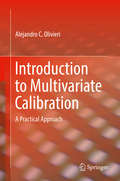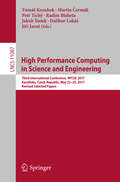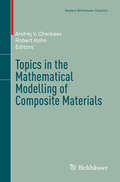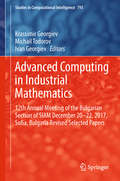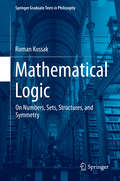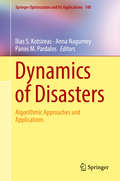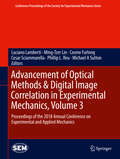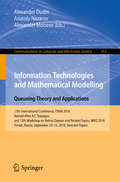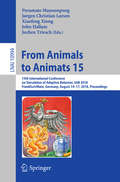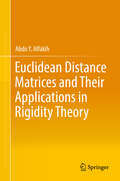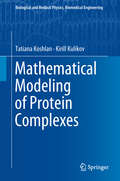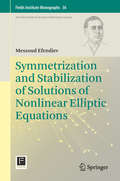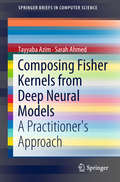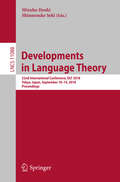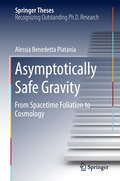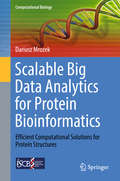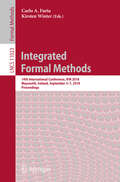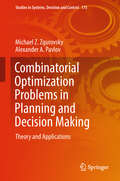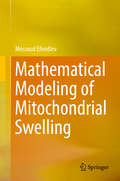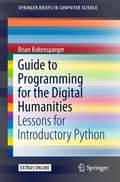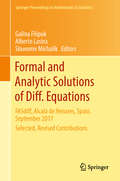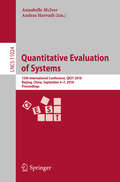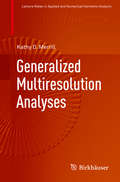- Table View
- List View
Introduction to Multivariate Calibration: A Practical Approach
by Alejandro C. OlivieriThis book offers an introductory-level guide to the complex field of multivariate analytical calibration, with particular emphasis on real applications such as near infrared spectroscopy. It presents intuitive descriptions of mathematical and statistical concepts, illustrated with a wealth of figures and diagrams, and consistently highlights physicochemical interpretation rather than mathematical issues. In addition, it describes an easy-to-use and freely available graphical interface, together with a variety of appropriate examples and exercises. Lastly, it discusses recent advances in the field (figures of merit, detection limit, non-linear calibration, method comparison), together with modern literature references.
High Performance Computing in Science and Engineering: Third International Conference, HPCSE 2017, Karolinka, Czech Republic, May 22–25, 2017, Revised Selected Papers (Lecture Notes in Computer Science #11087)
by Tomáš Kozubek Martin Čermák Petr Tichý Radim Blaheta Jakub Šístek Dalibor Lukáš Jiří JarošThis book constitutes the thoroughly refereed post-conference proceedings of the Third International Conference on High Performance Computing in Science and Engineering, HPCSE 2017, held in Karolinka, Czech Republic, in May 2017.The 15 papers presented in this volume were carefully reviewed and selected from 20 submissions. The conference provides an international forum for exchanging ideas among researchers involved in scientific and parallel computing, including theory and applications, as well as applied and computational mathematics. The focus of HPCSE 2017 was on models, algorithms, and software tools which facilitate efficient and convenient utilization of modern parallel and distributed computing architectures, as well as on large-scale applications.
Topics in the Mathematical Modelling of Composite Materials (Modern Birkhäuser Classics)
by Andrej V. Cherkaev Robert KohnOver the past several decades, we have witnessed a renaissance of theoretical work on the macroscopic behavior of microscopically heterogeneous materials. This activity brings together a number of related themes, including: (1) the use of weak convergence as a rigorous yet general language for the discussion of macroscopic behavior; (2) interest in new types of questions, particularly the "G-closure problem," motivated in large part by applications of optimal control theory to structural optimization; (3) the introduction of new methods for bounding effective moduli, including one based on "compensated compactness"; and (4) the identification of deep links between the analysis of microstructures and the multidimensional calculus of variations. This work has implications for many physical problems involving optimal design, composite materials, and coherent phase transitions. As a result, it has received attention and support from numerous scientific communities, including engineering, materials science, and physics, as well as mathematics. There is by now an extensive literature in this area. But for various reasons certain fundamental papers were never properly published, circulating instead as mimeographed notes or preprints. Other work appeared in poorly distributed conference proceedings volumes. Still other work was published in standard books or journals, but written in Russian or French. The net effect is a sort of "gap" in the literature, which has made the subject unnecessarily difficult for newcomers to penetrate. The present, softcover reprint is designed to make this classic text available to a wider audience. "Summarizes some of the fundamental results achieved and offers new perspectives in the mechanics of composite and micromechanics... Will become a classic in the two fields." —Applied Mechanics Review
Advanced Computing in Industrial Mathematics: 12th Annual Meeting of the Bulgarian Section of SIAM December 20-22, 2017, Sofia, Bulgaria Revised Selected Papers (Studies in Computational Intelligence #793)
by Krassimir Georgiev Michail Todorov Ivan GeorgievThis book gathers the peer-reviewed proceedings of the 12th Annual Meeting of the Bulgarian Section of the Society for Industrial and Applied Mathematics, BGSIAM’17, held in Sofia, Bulgaria, in December 2017. The general theme of BGSIAM’17 was industrial and applied mathematics, with a particular focus on: high-performance computing, numerical methods and algorithms, analysis of partial differential equations and their applications, mathematical biology, control and uncertain systems, stochastic models, molecular dynamics, neural networks, genetic algorithms, metaheuristics for optimization problems, generalized nets, and Big Data.
Mathematical Logic: On Numbers, Sets, Structures, and Symmetry (Springer Graduate Texts in Philosophy #3)
by Roman KossakThis book, presented in two parts, offers a slow introduction to mathematical logic, and several basic concepts of model theory, such as first-order definability, types, symmetries, and elementary extensions. Its first part, Logic Sets, and Numbers, shows how mathematical logic is used to develop the number structures of classical mathematics. The exposition does not assume any prerequisites; it is rigorous, but as informal as possible. All necessary concepts are introduced exactly as they would be in a course in mathematical logic; but are accompanied by more extensive introductory remarks and examples to motivate formal developments. The second part, Relations, Structures, Geometry, introduces several basic concepts of model theory, such as first-order definability, types, symmetries, and elementary extensions, and shows how they are used to study and classify mathematical structures. Although more advanced, this second part is accessible to the reader who is either already familiar with basic mathematical logic, or has carefully read the first part of the book. Classical developments in model theory, including the Compactness Theorem and its uses, are discussed. Other topics include tameness, minimality, and order minimality of structures. The book can be used as an introduction to model theory, but unlike standard texts, it does not require familiarity with abstract algebra. This book will also be of interest to mathematicians who know the technical aspects of the subject, but are not familiar with its history and philosophical background.
Dynamics of Disasters: Algorithmic Approaches and Applications (Springer Optimization and Its Applications #140)
by Ilias S. Kotsireas Anna Nagurney Panos M. PardalosThis book surveys new algorithmic approaches and applications to natural and man-made disasters such as oil spills, hurricanes, earthquakes and wildfires. Based on the “Third International Conference on Dynamics of Disasters” held in Kalamata, Greece, July 2017, this Work includes contributions in evacuation logistics, disaster communications between first responders, disaster relief, and a case study on humanitarian logistics. Multi-disciplinary theories, tools, techniques and methodologies are linked with disasters from mitigation and preparedness to response and recovery. The interdisciplinary approach to problems in economics, optimization, government, management, business, humanities, engineering, medicine, mathematics, computer science, behavioral studies, emergency services, and environmental studies will engage readers from a wide variety of fields and backgrounds.
Advancement of Optical Methods & Digital Image Correlation in Experimental Mechanics, Volume 3: Proceedings of the 2018 Annual Conference on Experimental and Applied Mechanics (Conference Proceedings of the Society for Experimental Mechanics Series)
by Luciano Lamberti Ming-Tzer Lin Cosme Furlong Cesar Sciammarella Phillip L. Reu Michael A SuttonAdvancement of Optical Methods & Digital Image Correlation in Experimental Mechanics, Volume 3 of the Proceedings of the 2018 SEM Annual Conference & Exposition on Experimental and Applied Mechanics, the third volume of eight from the Conference, brings together contributions to this important area of research and engineering. The collection presents early findings and case studies on a wide range of optical methods ranging from traditional photoelasticity and interferometry to more recent DIC and DVC techniques, and includes papers in the following general technical research areas: New Developments in Optical Methods & Fringe Pattern Analysis;DIC Applications for Challenging Environments;Optical Methods in SEM: History & Perspective;Mechanical Characterization of Materials & Structures with Optical Methods;Bioengineering.
Information Technologies and Mathematical Modelling. Queueing Theory and Applications: 17th International Conference, ITMM 2018, Named After A.F. Terpugov, and 12th Workshop on Retrial Queues and Related Topics, WRQ 2018, Tomsk, Russia, September 10-15, 2018, Selected Papers (Communications in Computer and Information Science #912)
by Alexander Dudin Anatoly Nazarov Alexander MoiseevThis book constitutes the proceedings of the 17th International Conference on Information Technologies and Mathematical Modelling, ITMM 2018, named after A.F. Terpugov, and the 12th Workshop on Retrial Queues and Related Topics, held in Tomsk, Russia, in September 2018. The 30 papers presented in this volume were carefully reviewed and selected from 84 submissions. The conference covers various aspects of information technologies, focusing on queueing theory, stochastic processes, Markov processes, renewal theory, network performance equation and network protocols.
From Animals to Animats 15: 15th International Conference on Simulation of Adaptive Behavior, SAB 2018, Frankfurt/Main, Germany, August 14-17, 2018, Proceedings (Lecture Notes in Computer Science #10994)
by Poramate Manoonpong Jørgen Christian Larsen Xiaofeng Xiong John Hallam Jochen TrieschThis book constitutes the refereed proceedings of the 15th International Conference on Simulation of Adaptive Behavior, SAB 2018, held in Frankfurt/Main, Germany, in August 2018.The 21 papers presented were carefully reviewed and selected from 39 submissions. They cover the main areas in animat research, including the animat approach and methodology, perception and motor control, action selection and navigation, learning and adaptation, and collective and social behavior.
Electromagnetic Fields Excited in Volumes with Spherical Boundaries (Lecture Notes in Electrical Engineering #523)
by Yuriy M. Penkin Victor A. Katrich Mikhail V. Nesterenko Sergey L. Berdnik Victor M. DakhovThis book discusses the problem of electromagnetic wave excitation in spatial regions with spherical boundaries and the accurate mathematical modeling based on numerical and analytical methods to significantly reduce the time required for developing new antenna devices. It particularly focuses on elements and systems on mobile objects of complex shape that are made of new technological materials. The experimental development of such devices and systems is an extremely time-consuming, lengthy, and expensive process. The book is intended for senior and postgraduate students and researchers working in the fields of radiophysics, radio engineering and antenna design. The authors assume that readers understand the basics of vector and tensor analysis, as well as the general theory of electrodynamics. The original results presented can be directly used in the development of spherical antennas and antenna systems for the mobile objects. The book addresses problems concerning the construction of Green’s functions for Hertz potentials in electrodynamic volumes with spherical boundaries, and solves these clearly and concisely. It also uses specific examples to analyze areas where the results could potentially be applied. The book covers the following topics: · excitation of electromagnetic fields in coordinate electrodynamic volumes; · Green’s functions for spherical resonators; · Green’s functions for infinite space outside of spherical scatterers; · electromagnetic fields of dipole radiators on spherical scatterers; · electromagnetic fields of thin radial impedance vibrators on perfectly conducting spheres; · electrodynamic characteristics of narrow slots in spherical surfaces; · multi-element and combined vibrator-slot radiators on spherical surfaces.
Euclidean Distance Matrices and Their Applications in Rigidity Theory
by Abdo Y. AlfakihThis book offers a comprehensive and accessible exposition of Euclidean Distance Matrices (EDMs) and rigidity theory of bar-and-joint frameworks. It is based on the one-to-one correspondence between EDMs and projected Gram matrices. Accordingly the machinery of semidefinite programming is a common thread that runs throughout the book. As a result, two parallel approaches to rigidity theory are presented. The first is traditional and more intuitive approach that is based on a vector representation of point configuration. The second is based on a Gram matrix representation of point configuration. Euclidean Distance Matrices and Their Applications in Rigidity Theory begins by establishing the necessary background needed for the rest of the book. The focus of Chapter 1 is on pertinent results from matrix theory, graph theory and convexity theory, while Chapter 2 is devoted to positive semidefinite (PSD) matrices due to the key role these matrices play in our approach. Chapters 3 to 7 provide detailed studies of EDMs, and in particular their various characterizations, classes, eigenvalues and geometry. Chapter 8 serves as a transitional chapter between EDMs and rigidity theory. Chapters 9 and 10 cover local and universal rigidities of bar-and-joint frameworks. This book is self-contained and should be accessible to a wide audience including students and researchers in statistics, operations research, computational biochemistry, engineering, computer science and mathematics.
Mathematical Modeling of Protein Complexes (Biological and Medical Physics, Biomedical Engineering)
by Tatiana Koshlan Kirill KulikovThis book is devoted to the physical and mathematical modeling of the formation of complexes of protein molecules. The models developed show remarkable sensitivity to the amino acid sequences of proteins, which facilitates experimental studies and allows one to reduce the associated costs by reducing the number of measurements required according to the developed criteria. These models make it possible to reach a conclusion about the interactions between different amino acid chains and to identify more stable sites on proteins. The models also take the phosphorylation of amino acid residues into account. At the end of the book, the authors present possible directions of application of their physical and mathematical models in clinical medicine.
Symmetrization and Stabilization of Solutions of Nonlinear Elliptic Equations (Fields Institute Monographs #36)
by Messoud EfendievThis book deals with a systematic study of a dynamical system approach to investigate the symmetrization and stabilization properties of nonnegative solutions of nonlinear elliptic problems in asymptotically symmetric unbounded domains. The usage of infinite dimensional dynamical systems methods for elliptic problems in unbounded domains as well as finite dimensional reduction of their dynamics requires new ideas and tools. To this end, both a trajectory dynamical systems approach and new Liouville type results for the solutions of some class of elliptic equations are used. The work also uses symmetry and monotonicity results for nonnegative solutions in order to characterize an asymptotic profile of solutions and compares a pure elliptic partial differential equations approach and a dynamical systems approach. The new results obtained will be particularly useful for mathematical biologists.
Composing Fisher Kernels from Deep Neural Models: A Practitioner's Approach (SpringerBriefs in Computer Science)
by Tayyaba Azim Sarah AhmedThis book shows machine learning enthusiasts and practitioners how to get the best of both worlds by deriving Fisher kernels from deep learning models. In addition, the book shares insight on how to store and retrieve large-dimensional Fisher vectors using feature selection and compression techniques. Feature selection and feature compression are two of the most popular off-the-shelf methods for reducing data’s high-dimensional memory footprint and thus making it suitable for large-scale visual retrieval and classification. Kernel methods long remained the de facto standard for solving large-scale object classification tasks using low-level features, until the revival of deep models in 2006. Later, they made a comeback with improved Fisher vectors in 2010. However, their supremacy was always challenged by various versions of deep models, now considered to be the state of the art for solving various machine learning and computer vision tasks. Although the two research paradigms differ significantly, the excellent performance of Fisher kernels on the Image Net large-scale object classification dataset has caught the attention of numerous kernel practitioners, and many have drawn parallels between the two frameworks for improving the empirical performance on benchmark classification tasks. Exploring concrete examples on different data sets, the book compares the computational and statistical aspects of different dimensionality reduction approaches and identifies metrics to show which approach is superior to the other for Fisher vector encodings. It also provides references to some of the most useful resources that could provide practitioners and machine learning enthusiasts a quick start for learning and implementing a variety of deep learning models and kernel functions.
Developments in Language Theory: 22nd International Conference, DLT 2018, Tokyo, Japan, September 10-14, 2018, Proceedings (Lecture Notes in Computer Science #11088)
by Mizuho Hoshi Shinnosuke SekiThis book constitutes the proceedings of the 22nd International Conference on Developments in Language Theory, DLT 2018, held in Tokyo, Japan, in September 2018. The 39 full papers presented in this volume were carefully reviewed and selected from 84 submissions. The papers cover the following topics and areas: combinatorial and algebraic properties of words and languages; grammars, acceptors and transducers for strings, trees, graphics, arrays; algebraic theories for automata and languages; codes; efficient text algorithms; symbolic dynamics; decision problems; relationships to complexity theory and logic; picture description and analysis, polyominoes and bidimensional patterns; cryptography; concurrency; celluar automata; bio-inspired computing; quantum computing.
Asymptotically Safe Gravity: From Spacetime Foliation to Cosmology (Springer Theses)
by Alessia Benedetta PlataniaThis book seeks to construct a consistent fundamental quantum theory of gravity, which is often considered one of the most challenging open problems in present-day physics. It approaches this challenge using modern functional renormalization group techniques, and attempts to realize the idea of “Asymptotic Safety” originally proposed by S. Weinberg. Quite remarkably, the book makes significant progress regarding both the fundamental aspects of the program and its phenomenological consequences. The conceptual developments pioneer the construction of a well-behaved functional renormalization group equation adapted to spacetimes with a preferred time-direction. It is demonstrated that the Asymptotic Safety mechanism persists in this setting and extends to many phenomenologically interesting gravity-matter systems. These achievements constitute groundbreaking steps towards bridging the gap between quantum gravity in Euclidean and Lorentzian spacetimes.The phenomenological applications cover core topics in quantum gravity, e.g. constructing a phenomenologically viable cosmological evolution based on quantum gravity effects in the very early universe, and analyzing quantum corrections to black holes forming from a spherical collapse.As a key feature, all developments are presented in a comprehensive and accessible way. This makes the work a timely and valuable guide into the rapidly evolving field of Asymptotic Safety.
Scalable Big Data Analytics for Protein Bioinformatics: Efficient Computational Solutions for Protein Structures (Computational Biology #28)
by Dariusz MrozekThis book presents a focus on proteins and their structures. The text describes various scalable solutions for protein structure similarity searching, carried out at main representation levels and for prediction of 3D structures of proteins. Emphasis is placed on techniques that can be used to accelerate similarity searches and protein structure modeling processes.The content of the book is divided into four parts. The first part provides background information on proteins and their representation levels, including a formal model of a 3D protein structure used in computational processes, and a brief overview of the technologies used in the solutions presented in the book. The second part of the book discusses Cloud services that are utilized in the development of scalable and reliable cloud applications for 3D protein structure similarity searching and protein structure prediction. The third part of the book shows the utilization of scalable Big Data computational frameworks, like Hadoop and Spark, in massive 3D protein structure alignments and identification of intrinsically disordered regions in protein structures. The fourth part of the book focuses on finding 3D protein structure similarities, accelerated with the use of GPUs and the use of multithreading and relational databases for efficient approximate searching on protein secondary structures.The book introduces advanced techniques and computational architectures that benefit from recent achievements in the field of computing and parallelism. Recent developments in computer science have allowed algorithms previously considered too time-consuming to now be efficiently used for applications in bioinformatics and the life sciences. Given its depth of coverage, the book will be of interest to researchers and software developers working in the fields of structural bioinformatics and biomedical databases.
Instruments for Health Surveys in Children and Adolescents (Springer Series on Epidemiology and Public Health)
by Karin Bammann Lauren Lissner Iris Pigeot Wolfgang AhrensThis book describes key methods and instruments for assessing diet-related factors, physical activity, social and environmental factors, physical characteristics and health-related outcomes in children and adolescents. These tools were developed and deployed within the framework of the pan-European IDEFICS and I.Family cohort studies. These population-based field studies were funded within the 6th and 7th European Framework Programme, respectively, and were intended to assess the prevalence and aetiology of lifestyle-related diseases in children, focusing on overweight and obesity, and to develop effective strategies for primary prevention. In the course of a decade we undertook a major research endeavour, collecting standardised data from children, families, neighbourhoods, kindergartens, pre-schools and schools in eight European countries, employing a uniform cross-cultural methodology. This resulted in a rich picture of the daily lives and living contexts of children and their families. Studies encompassing childhood and adolescence face the particular challenge of the transitions from pre-school to primary school and from childhood to adolescence; accordingly, the instruments used need to be adapted to different developmental stages while maintaining their comparability across the age range. In young children, questionnaires have to be completed by proxies, usually their parents, while older children, particularly adolescents, can provide a major part of the requested information themselves. This book presents suitable designs, methods and instruments for data collection in studies of children and adolescents. Each chapter explains the development and background of the instruments applied in the surveys and summarises the current state of knowledge. All chapters were written by key experts in their respective research fields. We are grateful for their valuable contributions and their enthusiastic support in producing this book, which also presents survey experiences in which practice does not always follow theory. Participants’ responses can on occasion be unexpected and unpredictable, but meeting these challenges can also enrich epidemiological surveys and yield methodological refinements. We sincerely hope that the book and the online material will be of considerable value to other research teams.
Integrated Formal Methods: 14th International Conference, IFM 2018, Maynooth, Ireland, September 5-7, 2018, Proceedings (Lecture Notes in Computer Science #11023)
by Carlo A. Furia Kirsten WinterThis book constitutes the refereed proceedings of the 14th International Conference on Integrated Formal Methods, IFM 2018, held in Maynooth, Ireland, in September 2018.The 17 full papers and 5 short papers presented together with 3 invited talks were carefully reviewed and selected from 60 submissions. The conference covers a broad spectrum of topics: from language design, to verification and analysis techniques, to supporting tools and their integration into software engineering practice.
Combinatorial Optimization Problems in Planning and Decision Making: Theory and Applications (Studies in Systems, Decision and Control #173)
by Michael Z. Zgurovsky Alexander A. PavlovThe book focuses on the next fields of computer science: combinatorial optimization, scheduling theory, decision theory, and computer-aided production management systems. It also offers a quick introduction into the theory of PSC-algorithms, which are a new class of efficient methods for intractable problems of combinatorial optimization. A PSC-algorithm is an algorithm which includes: sufficient conditions of a feasible solution optimality for which their checking can be implemented only at the stage of a feasible solution construction, and this construction is carried out by a polynomial algorithm (the first polynomial component of the PSC-algorithm); an approximation algorithm with polynomial complexity (the second polynomial component of the PSC-algorithm); also, for NP-hard combinatorial optimization problems, an exact subalgorithm if sufficient conditions were found, fulfilment of which during the algorithm execution turns it into a polynomial complexity algorithm. Practitioners and software developers will find the book useful for implementing advanced methods of production organization in the fields of planning (including operative planning) and decision making. Scientists, graduate and master students, or system engineers who are interested in problems of combinatorial optimization, decision making with poorly formalized overall goals, or a multiple regression construction will benefit from this book.
Mathematical Modeling of Mitochondrial Swelling
by Messoud EfendievThe mathematical models considered in this book can help to understand the swelling of mitochondria. For the first time, it presents new mathematical models of mitochondrial swelling that take into account, in particular, spatial effects. The results presented here could make it possible to predict properties of the underlying biological mechanisms. Taking into account that mitochondria could move within a cell, lead to a PDE-PDE model. The book discusses the well-posedness and long-term dynamics of solutions, depending on boundary conditions reflecting the in vitro and in vivo cases. These analytical and numerical results have inspired colleagues from the Institute of Pharmacology and Toxicology of the Helmholtz Center Munich to design new experiments justifying the theoretical and numerical results that are obtained. The book is intended for graduates students and researchers with a solid mathematical background and an interest in cell biology.
Guide to Programming for the Digital Humanities: Lessons for Introductory Python (SpringerBriefs in Computer Science)
by Brian KokenspargerAs an introduction to programming for the Digital Humanities (DH), this book presents six key assignments oriented on DH topics. The topics include Computing Change Over Time (calculating burials at a historic cemetery), Visualizing Change Over Time (visualizing the burials at the historic cemetery), Textual Analysis (finding word frequencies and “stop words” in public domain texts), XML Transformation (transforming a simplified version of XML into HTML styled with CSS), Stylometry (comparing the measured features of graphic images), and Social Network Analysis (analyzing extended relationships in historic circles). The book focuses on the practical application of these assignments in the classroom, providing a range of variations for each assignment, which can be selected on the basis of students’ specific programming background and skills; “atomic” assignments, which can be used to give students the experience they need to successfully complete the main assignments; and some common pitfalls and gotchas to manage in the classroom. The book’s chief goals are to introduce novice computer science (CS) students to programming for DH, and to offer them valuable hands-on experience with core programming concepts.
Formal and Analytic Solutions of Diff. Equations: FASdiff, Alcalá de Henares, Spain, September 2017, Selected, Revised Contributions (Springer Proceedings in Mathematics & Statistics #256)
by Galina Filipuk Alberto Lastra Sławomir MichalikThese proceedings provide methods, techniques, different mathematical tools and recent results in the study of formal and analytic solutions to Diff. (differential, partial differential, difference, q-difference, q-difference-differential.... ) Equations. They consist of selected contributions from the conference "Formal and Analytic Solutions of Diff. Equations", held at Alcalá de Henares, Spain during September 4-8, 2017. Their topics include summability and asymptotic study of both ordinary and partial differential equations. The volume is divided into four parts. The first paper is a survey of the elements of nonlinear analysis. It describes the algorithms to obtain asymptotic expansion of solutions of nonlinear algebraic, ordinary differential, partial differential equations, and of systems of such equations. Five works on formal and analytic solutions of PDEs are followed by five papers on the study of solutions of ODEs. The proceedings conclude with five works on related topics, generalizations and applications. All contributions have been peer reviewed by anonymous referees chosen among the experts on the subject.The volume will be of interest to graduate students and researchers in theoretical and applied mathematics, physics and engineering seeking an overview of the recent trends in the theory of formal and analytic solutions of functional (differential, partial differential, difference, q-difference, q-difference-differential) equations in the complex domain.
Quantitative Evaluation of Systems: 15th International Conference, QEST 2018, Beijing, China, September 4-7, 2018, Proceedings (Lecture Notes in Computer Science #11024)
by Annabelle McIver Andras HorvathThis book constitutes the proceedings of the 15th International Conference on Quantitative Evaluation Systems, QEST 2018, held in Beijing, China, in September 2018. The 24 full papers presented were carefully reviewed and selected from 51 submissions. The papers cover topics in the field of quantitative evaluation and verification of computer systems and networks through stochastic models and measurements emphasizing two frontier topics in research: quantitative information flow for security and industrial formal methods.
Generalized Multiresolution Analyses (Applied and Numerical Harmonic Analysis)
by Kathy D. MerrillThis monograph presents the first unified exposition of generalized multiresolution analyses. Expanding on the author’s pioneering work in the field, these lecture notes provide the tools and framework for using GMRAs to extend results from classical wavelet analysis to a more general setting. Beginning with the basic properties of GMRAs, the book goes on to explore the multiplicity and dimension functions of GMRA, wavelet sets, and generalized filters. The author’s constructions of wavelet sets feature prominently, with figures to illustrate their remarkably simple geometric form. The last three chapters exhibit extensions of wavelet theory and GMRAs to other settings. These include fractal spaces, wavelets with composite dilations, and abstract constructions of GMRAs beyond the usual setting of L2(ℝn).This account of recent developments in wavelet theory will appeal to researchers and graduate students with an interest in multiscale analysis from a pure or applied perspective. Familiarity with harmonic analysis and operator theory will be helpful to the reader, though the only prerequisite is graduate level experience with real and functional analysis.
